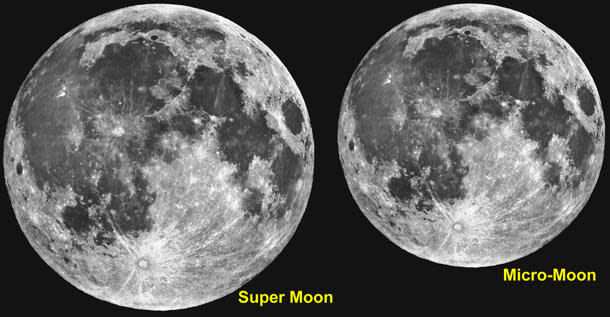 Science and Weather
Science and WeatherTonight’s ‘micro-moon’ is the smallest full moon of 2014
Although it may not look like it from month to month, not all full moons are created equal. Some are bigger and some are smaller, and January's full moon, which happens tonight, on the 15th, is the smallest full moon of the year!
Unlike the 'supermoon', which happens three times this year (due to its rather arbitrary astrological definition), tonight's apogee full moon, or 'micro-moon' is a once-in-the-year event!
At just before midnight, Eastern Time, the moon will be full at a distance of about 406,536 kilometres away from us, or just 184 kilometres shy of its maximum apogee — the farthest distance it can reach from Earth. That means that when you look up into the sky tonight, you'll be seeing the smallest full moon that will grace our skies all year long.
It's not easy to spot the different sizes in the full moons from our vantage point here on Earth. Our brains tend to play tricks on us when the moon is near the horizon compared to when it's high in the sky (the so-called 'moon illusion'). Also, it's hard to take accurate measurements when you're just going about your nightly business — unless, of course, your nightly business is being an astronomer who is taking measurements of the moon. However, taking careful observations or comparing really good pictures of the various full moons shows that the 'micro-moon' can be up to 14 per cent smaller than the 'supermoon.'
One of the great things about viewing the full moon during the winter months (at least in the northern hemisphere) is that we get the best views of it at this time of year. Minute Physics put out a great little video to explain why:
[ More Geekquinox: Hubble telescope spies massive star set to explode ]
These micromoons and supermoons are a great way to highlight some of the cool physics that happens around us — specifically about how the orbits of most of the objects in our solar system aren't circles, but instead are ellipses. Just as the Earth's elliptical orbit brings us closest to the sun at perigee (in January) and farthest from the sun at apogee (in July), the moon's orbit brings it closer to and farther from us as it goes around. Every month has its own perigee and apogee, of course, with no two really being the same. The closest perigee full moon, or supermoon, will be on August 10th this year.
It's just neat that this particular apogee moon happens to coincide with the full moon this month. Also, since January's full moon is called the Full Wolf Moon, maybe we should call this one the Full Wolf Cub Moon.
(Moon image courtesy: NASA & Lick Observatory, edited by author)
Geek out with the latest in science and weather.
Follow @ygeekquinox on Twitter!



